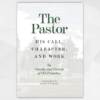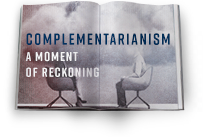Essential and Indispensable: Women and the Mission of the Church
Women’s contribution to the mission of the church is not just “important” or “vital” or “critical.” Women are “essential and indispensable” to the church’s mission and ministry. So says speaker and writer Jen Wilkin of The Village Church in Flower Mound, Texas.
I don’t know anyone who denies this. But when I heard her say it, it struck me. Why haven’t I heard it put this way? Why haven’t I said it? With the complementarian emphasis on elders, have we failed to recognize the essential and indispensable role men and women both play in fulfilling the great commission through our churches.
I don’t agree with everything Wilkin says about women and the church, but she’s spot-on right here. The Bible tells us so. It does not treat women’s work—Wilkin again—as “nice, but not necessary.” Rather, the Bible says women are essential and indispensable to fulfilling the Cultural Mandate’s command to multiply and fill, to subdue and rule. And it says they’re essential and indispensable to fulfilling the Great Commission’s call to make disciples.
THE ESSENTIAL & INDISPENSABLE MINISTRY OF WOMEN IN THE OLD TESTAMENT
Under the Old Covenant, women’s ministry—to risk an anachronism—was tied to motherhood generally as well as to protecting the seed of Abraham specifically.[1] God blessed the barren wombs of Sarah and Rebekah, as well as the wombs of the enslaved Hebrew women in Egypt, who literally gave birth to a people. In the face of Satanic attack, God again and again preserved Christ’s anointed line through mothers like Tamar, Ruth, and Bathsheba, but also in other ways as with Deborah and Esther.
Bible scholar Stephen Dempster summarizes this Old Testament theme as “woman against the beast”:
Eve versus the serpent; Sarah and Rebekah versus barrenness; Tamar versus Judah; Jochebed and Miriam versus the Pharaoh; Deborah and Jael versus Sisera; Ruth and Naomi versus death; Hannah versus barrenness; Jehosheba versus Athaliah. In all these examples of struggle these women of faith are engaged in a battle to save the people of God. The victory of Esther over Haman dramatically continues this theme. [2]
THE ESSENTIAL & INDISPENSABLE MINISTRY OF WOMEN IN THE NEW TESTAMENT
Motherhood and the war against the beast remains a crucial theme moving into the New Testament, starting with the story of Mary and the serpent’s attempt to destroy by Herod’s hand the singular seed toward whom the entire Old Testament points.
Motherhood also remains relevant for the work of churches. Paul encourages women to work out their salvation through child-bearing (1 Tim. 2:15), younger widows to marry (1 Tim. 5:14), and older women to train younger women to love their husbands and children (Titus 2:3–5). He also asks his readers to think of the honor we give to our mothers as the model for how we should treat older women (1 Tim. 5:2). And how many children learn the faith from their mothers and grandmothers, as Timothy did (2 Tim. 2:5).
Yet the new covenant also brings new dimensions to “women’s ministry.”
Disciples
For starters, the New Testament treats every Christian woman as a “disciple.” Disciples embody their master’s teaching and follow in the master’s way. In the Ancient Near East, women wouldn’t have been welcomed as disciples into the fellowship of a rabbi or some great master. The Jewish historian Josephus held them to be inferior. The Jewish philosopher Philo referred to women and feminine traits as examples of weakness. He said they should stay home in seclusion. Jewish men would use the rabinnic Tosefta to pray and thank God they were not women. [3]
It is against this backdrop that Jesus welcomed Mary to “sit at the Lord’s feet and listen to his teaching,” even as Saul was “educated at the feet of Gamaliel according to the strict manner of the law of our fathers” (Luke 10:39; Acts 22:3). He told Martha, who was “distracted with much serving,” that Mary had chosen “the good portion” (vv. 40, 42).
Do we dare, today, offer a different path for women than Jesus offered? Do we dare keep women from choosing the good portion of learning every doctrine, principle, and command requisite to know and follow him?
Jesus specially chose twelve male disciples. Yet he also taught a larger group to be disciples (Matt. 8:21; 10:24–25, 42; 27;57), which included women. He travelled and preached with the twelve “and also some women,” including Mary Magdalene, Joanna, Suzanna, and “many others who provided for them out of their means” (Luke 8:2–3).
Such women even end up appearing more faithful than the twelve. The men abandon Jesus upon his arrest. But women follow him to the crucifixion (Matt. 27:55–56; Mark 15:40; Luke 23:49; John 19:25–27); join Joseph of Arimathea for the burial (Matt. 27:57–61; Mark 15:45–47; Luke 23:50–55); and are the first to visit the tomb (Matt 28:1; Mark 16:1; Luke 24:1; John 20:1). Against Ancient Near East standards for reliable witnesses, the Bible presents them as the first to testify to the resurrection (Matt. 28:7–10; Luke 24:8-12; John 20:2).[4]
Today, how often are women the more faithful workers in our churches? Who do we think the heavenly Father counts as “first” in the kingdom of heaven? European art galleries are filled with paintings of the great men of Christendom, but heaven’s art galleries could look a little different.
Prophetesses and witnesses
After Jesus’s ascension, the New Testament records the Spirit filling men and women alike, just as the prophet Joel had promised: a new eschatological era would come in which God would “pour out my Spirit on all flesh, and your sons and your daughters shall prophesy” and “that everyone who calls upon the name of the Lord shall be saved’ (Acts 2:17, 21). Through the narrative of Acts, Luke continues to highlight God’s work among women: Mary, the mother of Jesus; Tabitha, or Dorcas; Mary, the mother of John Mark; Rhoda, the servant girl; Lydia of Thyatira; Damaris the Areopagite; Priscilla; and the four prophetesses in Acts 21:9.
We don’t need to concern ourselves here with whether or not the gift of prophesy continues today. The point is simply that the new covenant promises an equal share of God’s Spirit among men and women alike for the purposes of witness and disciple making. Remember how Luke began the book with Jesus’s promise: “You will receive power when the Holy Spirit has come upon you, and you will be my witnesses in Jerusalem and in all Judea and Samaria, and to the end of the earth” (Acts 1:8).
Priests
Related to the gift of the Spirit is the fact that every believing woman is now given the ministry of New Testament priest (1 Peter 2:9; Rev. 1:6; 5:10). Nowhere does the New Testament deliberately single out women relative to men in this task. Yet the office and the work is given to all believers.
Both women and men must assume the work of battling against satanic incursions and keeping the line clear between church and world, Christ and Belial, the holy and the unholy (2 Cor. 6:14–7:1). Both must “contend for the faith” against false teachers (Jude 3). Both, for their part, must protect and teach the Word of God to the next generation (e.g. Acts 18:26; Titus 2:3–5).
If you’re a congregationalist like me, therefore, you affirm that women, together with men, exercise the highest earthly authority in the church. Together, as disciples and priests, they must make decisions regarding the what and the who of the gospel (e.g. Matt. 18:17; 1 Cor. 5; 2 Cor. 2:6; Gal. 6:1–9). Filled with the Spirit and the knowledge of God (see Jer. 31:33–34), women must decide and formally declare together with men, “Is this a true confession? Is this a true confessor?”
The kind of authority possessed by men and women together is the authority to make a church a church. Which means: the authority held by women together with men is more essential and indispensable to the existence of the church than elder authority. Churches can exist (albeit in weaker form) without elders (see Acts 14:23 and Titus 1:5). Churches cannot exist at all without men and women gathering in Jesus’ name (Matt. 18:20) and registering their official “agreement” upon the gospel (v. 19), thereby exercising the keys of the kingdom of heaven (v. 18).
Fellow workers
Turn to the ministry of Paul, he counts Prisca his “fellow worker” (Rom. 16:3). Throughout Romans 16, Paul lists twice as many men (19) as women (10), but he commends twice as many women as men. [5] He commends three men as working for the gospel (Urbanus, Aquila, and Adronicus, the latter two of whom are coupled with women); but he also commends seven of the ten women for such gospel work (Phoebe, Prisca, Junia, Maria, Tryphaena, Tryphosa, and Persis). Tryphaena, Tryphosa and Persis are “working hard in the Lord.” Maria “worked hard among you.” [6] Prisca risked her neck for Paul, together with her husband. Junia joined him in prison, together with her husband. And Pheobe acted as a patron for both him and others, and probably travelled hundreds of dangerous miles to deliver his letter to the Romans.
Paul limited the office of elder to men (1 Tim. 2:12), but he surely knew how essential and indispensable women were to his ministry specifically and the Great Commission generally.
RELATIVIZING MOTHERHOOD (AND FATHERHOOD)
Yet as we list out a woman’s new covenant job description, notice what’s going on in the background: redemption history was progressing. The seed of Abraham had come, relativizing the importance of motherhood (and fatherhood), even Christ’s new covenant relativized Jewish identity and the role of family generally. “Looking about at those who sat around him,” Jesus observed, “Here are my mother and my brothers! For whoever does the will of God, he is my brother and sister and mother” (Mark 3:34–35; also, Luke 14:16). And John the Baptist tells the Jewish leaders, “Do not presume to say to yourselves, ‘We have Abraham as our father,’ for I tell you, God is able from these stones to raise up children for Abraham” (Matt. 3:8).
Creation history continues in the New Testament, as does the cultural mandate. Men must continue to father and women to mother. Such work is glorious, crucial, and necessary. And God uses these roles for redemptive purposes.
Yet the new covenant brings discontinuity to redemptive history as well. First, the new covenant ushers in a new order of fatherhood and motherhood, one conceived in spiritual terms and not physical ones, as when Paul refers to Titus as his “true child” in the faith. Every Christian must therefore strive to multiply image-bearers not through procreation, but through evangelism and conversion, such that people will be “born again” and “renewed” in the “image of the creator” (John 3:1-8; Col. 3:10).
By this token, second, God’s people are no longer constituted by lines of family descent. They no longer depend upon mothers and fathers as they did in ancient Israel. The type gives way to the antitype. (But see my appendix below: “Credobaptist vs. Paedobaptist Complementarianism”) Through Christ the firstborn we become “God’s family” by repentance and faith. Singleness, unheard of in the Old Testament, becomes a special gift in the New (1 Cor. 7:7) and universal in the new heavens and earth (Matt. 22:30). Family relationships also assume the role of signs for the new covenant community. God commands us to treat an older man as a “father, younger men as brothers, older women as mothers, younger women as sisters” (1 Tim. 5:1–2).
WHERE WOMEN’S MINISTRY BEGINS
What does this transition from the old covenant to the new mean for where a woman’s ministry begins? No doubt, women (together with their husbands) should strive to do new covenant ministry in the home by making disciples of their children.
Yet Christian women of every marital and parental status should jump into “women’s ministry” every week by doing the work of making disciples. Every week, every woman should go to work ministering to the saints, using whatever gifts she has for the common good. Those gifts may or may not be publicly recognized. That’s not the point. Either way her job (like a man’s job) is to look around the room at the collection of mothers and fathers, sisters and brothers, and ask herself whom she might serve. Should she offer that lonely sister a word of encouragement or instruction? Or offer that family logistical help? Or be like Pheobe and employ her resources as a “patron” to the elders? There’s never a shortage of new covenant, gospel work to be done. Just ask Phoebe, Prisca, Junia, Maria, Tryphaena, Tryphosa, and Persis.
Further, there’s never a shortage of serpentine or beastly attacks against the church. Every woman, therefore, should desire to be equipped for the work of the ministry of building up the body of Christ, so that the church might reach mature manhood and the stature and measure and fullness of Christ. This will keep the church from being tossed about by the cunning of false doctrine (Eph. 4:11–14). Every woman needs rock solid doctrine. Imagine if every woman in your church had it. What kind of protection do you think that would afford your church?!
Outside the body of believers, of course, women should use whatever skills and gifts God has given them to make disciples among those who don’t believe.
THE SAME OR COMPLEMENTARY?
Other than the office of elder, then, a woman’s new covenant ministry job description (disciple, witness, priest, fellow worker) appears parallel to a man’s, at least at first glance. Save the office and work of an elder, the same bullet points appear in both. Yet when the man and the woman get to work, their work will look different, just as a man and a woman singing the same song will sound different. After all, creation-history continues, we remain embodied men and women, and God has designed us differently. Not only that, women will often be able to move into female spaces more easily than men.
Once upon a time, my wife belonged to a women’s Bible study in which two of the women had difficult husbands. One evening the woman with the worse of the two husbands shared the encouragement she had received recently from God’s Word, and how it was sustaining her. Her words, in that moment, managed to do more spiritual good in the other woman’s life than a number of counseling sessions with an elder had managed to do.
For all the honor we owe to elders, this shouldn’t surprise us. Every part of the body needs every other part.
Women’s ministry is essential and indispensable, in other words, because women possess perspectives and opportunities that men don’t. Indeed, if God created us male and female, women possess a way of being human that men don’t, which means they possess ways of disciple-making that men don’t, however we might articulate those differences of being and doing (on this, see Alistair Robert’s article and Kevin DeYoung’s article). Men cannot do it all. Both sexes are essential and indispensable.
In other words, complementarianism by definition is an argument for including women in ministry, not excluding them, as the very word “complementarian” communicates. Like yin and yang, the two complementary parts are essential and indispensable to the whole.
Meanwhile, egalitarianism, at least at the structural level, must be indifferent to the inclusion or exclusion of gender. So badly does it want to insist upon a perfect vocational interchangeability that it must mute any ontological diversity and adopt a kind of androgyny. Yet when men and women become interchangeable, both become disposable, at least as a class. Neither are essential and indispensable.
In short, God calls the elders uniquely and crucially to teach the Word to “all the flock.” Yet the work of the Word has just begun. That Word must be massaged throughout the life of the whole body, and disciples must be made outside the church. And this task depends essentially and indispensably on both women and men, each doing in their own way and each contributing their God-given strengths.
WHAT I DON’T MEAN
Notice, finally, what I’m not saying. I’m not saying what is so often said today—that now is the time to emphasize what women can do, not what they can’t do.
“What can’t we do” is always a good question for every Christian, man or woman. Spiritual growth in the Bible doesn’t only or even primarily come when we are freed from all restrictions. It generally comes when we do restrict ourselves through obedience, discipline, and boundaries, much like a tree grows when aided by stilts, a rose grows through trimming, an athlete grows through training, and a student grows by memorizing a lesson.
Jesus himself submitted entirely to God’s law, and that was the means by which he grew in wisdom and stature among men and ultimately received all authority in heaven and on earth.
Growth without restraints, in fact, is precisely what the evil one promises in Genesis 3.
Second, I’m not saying that we “marginalize” women by not hiring them, or that we dishonor them by not calling them “leaders.” (See Sam Emadi’s article on this topic.) Both of these claims make the error of insisting upon a particular form of ministry that’s not in the Bible and then evaluating the faithfulness of a church by that humanly devised form.
More specifically, such statements confuse biblical mandates and responsibilities with the programmatic forms of the corporate world: “If you want something done, you need to hire someone to do it!” That’s how we lead companies, not families (churches), a point Peter implicitly affirms when he forbids elders—and therefore presumably everyone else—from being overly concerned with pay (1 Peter 5:2).
Further, the generic word “leader,” I fear, is often used to make an end-run around the biblical office of elder. “Yes, only men can be elders,” complementarians will affirm, but then run their ministries through “leadership” teams that have the effect of changing a rose’s name even as it still smells as sweet.
To be clear: I have absolutely no objection with a woman “leading” a diaconal ministry, or with hiring a woman to minister to the church in various capacities. It may often be wise. Several pastor friends of mine of medium-sized churches have hired women’s ministry directors to help facilitate how women in the church care for one another. And they all swear it was one of the best hires they have made. Further, I’m tempted to write another long article on how just the diaconal work of women plays a central part of what makes women’s ministry essential and indispensable.
Yet what I’m allergic to is turning what the Bible treats as “cans” into “musts,” and then evaluating the faithfulness of a church accordingly. Paul could give instructions “in all the churches” (1 Cor. 14:33). We can’t.
CONCLUSION
The essential and indispensable nature of women for the mission of the church does not depend upon any form of programmatic or paid ministry. It depends on what Christ has made women through dying and rising for them: disciples, witnesses, priests, fellow-workers.
It depends on his work and revealed wisdom, not our programmatic wisdom.
In complementarian circles, we rightly emphasize the Bible’s emphasis on the oversight and teaching of elders. But this emphasis should never cause us to forsake the essential and indispensable work that God gives to men and women alike as disciples, witnesses, and priests. He has determined that, apart from their work, the Great Commission will not succeed.
Pastor, how are you doing at teaching and demonstrating to the women in your church that their work is essential and indispensable?
* * * * *
Appendix: Credobaptist vs. Paedobaptist Complementarianism
In light of the biblical discussion above about the movement from the old to the new covenant, it’s worth noting that a credobaptist’s complementarianism and view of women’s ministry, if consistent, might feel a little different than a paedobaptist’s complementarianism and view of women’s ministry.
A paedobaptist’s complementarianism, leaning deeply into the lines of covenantal continuity, might feel a little more “Old Testament-ee.” After all, a woman’s work of bearing children plays the same role of building and preserving that community that it played under the Old Covenant, which paedobaptist’s demonstrate by baptizing infants into the covenant community and the church. Child-bearing almost becomes disciple-making and church-building in a faithful home. Therefore, one might expect a comparatively bigger emphasis on large families and homeschooling and the ministry of motherhood and fatherhood. Why not make those families as large as possible so that children might enjoy whatever covenantal blessings paedobaptists say they enjoy?
A credobaptist’s complementarianism must not neglect the emphases and gift of parenthood. Creation-history continues, after all. God commands us to be fruitful and multiply, and he means for Christians to faithfully employ family relationships for redemptive purposes, even as Timothy’s mother and grandmother did with him. But those family relationships no longer constitute the covenant community. Faith does.
To be sure, both the paedobaptist and credobaptist woman may respond, “Why not both/and? Why not the creation-covenant ministry of motherhood (and fatherhood) and the new-covenant ministries of disciples, priests, and fellow-workers?” They can and should. I’m simply suggesting that these different theologies of who constitutes the church—believers or believers and their children—can impact the emphases of a church, the language used in a Sunday School classroom, the culture of a church, the brand of complementarianism which grows up, and a church’s views of the duties of mother and fathers alike relative to other new covenant responsibilities.
[1] See James M. Hamilton, Jr., “A Biblical Theology of Motherhood,” in Journal of Discipleship and Family Ministry 2.2 (2012): 6-13.
[2] Stephen Dempster, Dominion and Dynasty (Downers Grove, IL: IVP), 223.
[3] These examples taken from D. M. Scholer, “Women,” in Dictionary of Jesus and the Gospels, edited by Joel B. Green, Scot McKnight, and I. Howard Marshall (Downers Grove, IL: IVP, 1992), 880.
[4] See Michelle Lee-Barnewall’s excellent section “Women as Disciples,” in the poorly titled Neither Complementarian nor Egalitarian: A Kingdom Corrective to the Evangelical Gender Debate (Grand Rapids, MI: Baker, 2016), 93–97.
[5] Craig Keener, “Man and Woman,” in Dictionary of Paul and His Letters, edited by Gerald F. Hawthorne, Ralph P. Martin, Daniel G. Reid (Downers Grove, IL: IVP, 1993), 589.
[6] See Dominika Kurek-Chomycz, “Tryphaena and Tryphosa: not too dainty to work hard in the Lord,” in L’Osservatore Romano (Sept. 1, 2018): http://www.osservatoreromano.va/en/news/tryphena-and-tryphosa.









